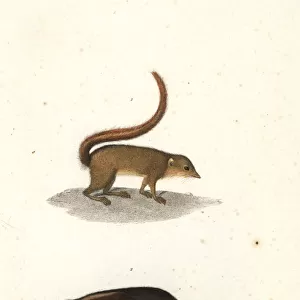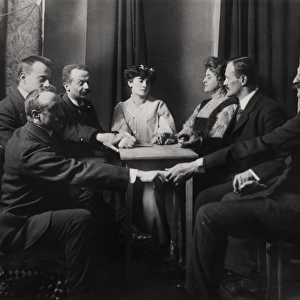Home > Animals > Mammals > Tupaiidae > Common Treeshrew
Common mole, Talpa europaea, and large treeshrew
![]()

Wall Art and Photo Gifts from Mary Evans Picture Library
Common mole, Talpa europaea, and large treeshrew
Common mole, Talpa europaea, and large treeshrew, Tupaia tana.. Handcolored copperplate stipple engraving from Frederic Cuviers Dictionary of Natural Science: Mammals, Paris, France, 1816. Illustration by J. G. Pretre, engraved by Gelee, directed by Pierre Jean-Francois Turpin, and published by F.G. Levrault. Jean Gabriel Pretre (1780-1845) was painter of natural history at Empress Josephines zoo and later became artist to the Museum of Natural History
Mary Evans Picture Library makes available wonderful images created for people to enjoy over the centuries
Media ID 14215047
© Florilegius / Mary Evans
Common Cuvier Dictionary Europaea Frederic Gabriel Mole Pretre Stipple Talpa Tana Treeshrew Tupaia
FEATURES IN THESE COLLECTIONS
> Animals
> Mammals
> Tupaiidae
> Common Treeshrew
> Arts
> Artists
> Related Images
> Europe
> France
> Paris
> Related Images
EDITORS COMMENTS
This exquisitely hand-colored copperplate stipple engraving, taken from Frederic Cuvier's Dictionary of Natural Science: Mammals, published in Paris, France, in 1816, showcases two fascinating mammals of the old world: the Common Mole (Talpa europaea) and the Large Treeshrew (Tupaia tana). The illustration was created by the skilled hand of Jean Gabriel Pretre, a painter of natural history at Empress Josephine's zoo, and later becoming an artist at the Museum of Natural History. The Common Mole, depicted on the left side of the engraving, is a small, burrowing mammal with a round, almost hairless body, short limbs, and a long, snout-like snout. They are excellent diggers, using their powerful forelimbs to excavate complex tunnel systems in search of earthworms and other invertebrates. Their eyes and ears are tiny, and they rely on their highly sensitive sense of touch to navigate their subterranean world. On the right side of the engraving, the Large Treeshrew, also known as the Greater Slow Loris, is depicted. This arboreal mammal is characterized by its large, round eyes, bushy tail, and long, prehensile limbs, which enable it to move easily through the trees of its rainforest habitat. They are primarily nocturnal, and their diet consists mainly of fruit, leaves, and insects. The intricate details of these animals' features are beautifully captured in this historical engraving, which showcases the meticulous craftsmanship of the time. The use of hand-coloring adds an additional layer of depth and vibrancy to the illustration, making it a stunning addition to any collection of natural history or zoology.
MADE IN AUSTRALIA
Safe Shipping with 30 Day Money Back Guarantee
FREE PERSONALISATION*
We are proud to offer a range of customisation features including Personalised Captions, Color Filters and Picture Zoom Tools
SECURE PAYMENTS
We happily accept a wide range of payment options so you can pay for the things you need in the way that is most convenient for you
* Options may vary by product and licensing agreement. Zoomed Pictures can be adjusted in the Cart.





